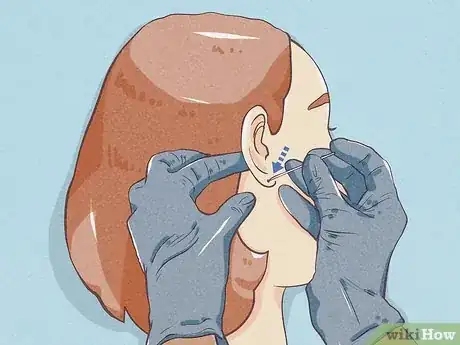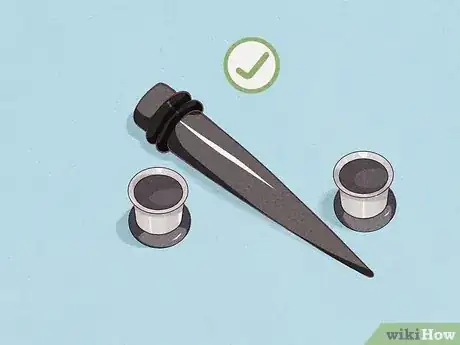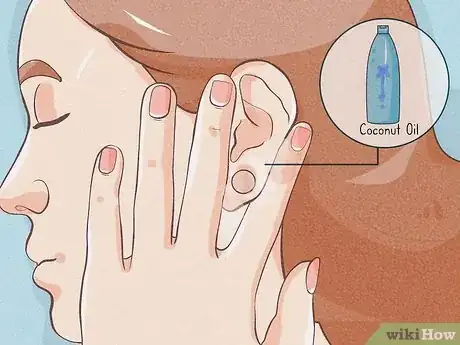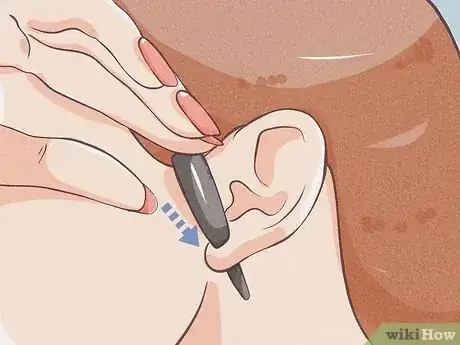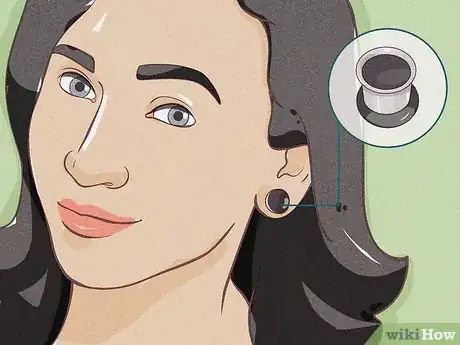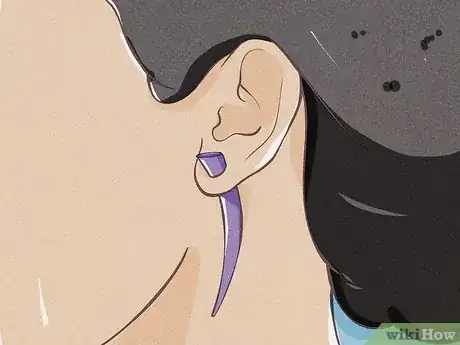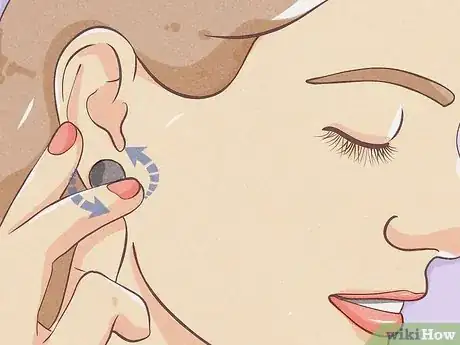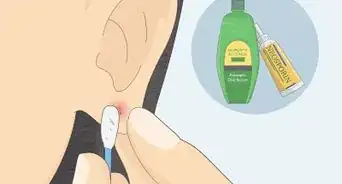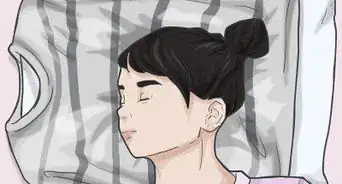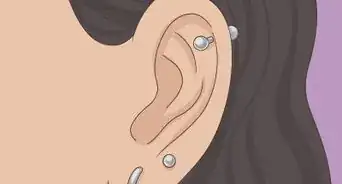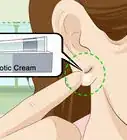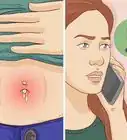This article was co-authored by David Wilkins. David Wilkins is a Professional Body Piercer and the Owner of The Axiom Body Piercing Studio in Des Moines, Iowa. David has been working in the industry since 1994 and is knowledgeable about all aspects of the body piercing industry. He runs an educational YouTube channel specializing in sharing expert body piercings and tattoo information. He completed his apprenticeship in body piercing in Omaha, Nebraska.
There are 12 references cited in this article, which can be found at the bottom of the page.
wikiHow marks an article as reader-approved once it receives enough positive feedback. In this case, 100% of readers who voted found the article helpful, earning it our reader-approved status.
This article has been viewed 2,266,933 times.
Ear gauges are a bold and stylish way to express your individuality. If you've always wanted to stretch your ears to accommodate gauges, you can do so from the comfort of your home. Just get your ears pierced at a local studio, then use professional tools like tapers and surgical tape to stretch the holes out over time. As long as you have patience and practice good hygiene, you can stretch your ears safely.
Steps
Inserting Your First Taper into Your Ear
-
1Get your ears pierced at a trustworthy location. Although you can stretch your ears at home, you will need to get them pierced at a professional establishment. Piercing your ears at home increases your risk of infection, especially if you are stretching your ears afterward. You will be unable to use the same sterile equipment and technique as a licensed professional.
-
2Wait 6-10 weeks after piercing your ears to stretch them. Piercings must be fully healed before it is safe to stretch. If you do not want to wait the full ten weeks, watch for signs of healing. A healed ear piercing will not be tender to the touch and will not close if the piercing is removed for longer than several hours.[1]
- Do not stretch your ears if your piercing is infected. Signs of infection include swelling, yellow or greenish discharge, redness, irritation, and bleeding.[2]
- A good rule of thumb is that you should wait twice the minimum period of healing. If it takes two months to heal, then you should wait at least another four months before stretching.
-
3Begin stretching your ear with a size 16 or 14 gauge. Ears are typically pierced using an 18 or 20 gauge, so 14 is the largest size you can start on and avoid damaging your ears. Starting at any larger than this size puts your ear at-risk of tearing.[3]
-
4Purchase a set of ear tapers at a piercing studio. Many piercing studios offer a "stretching kit" of ear tapers in various sizes. Start with your size 16-14 ear taper, depending on your chosen gauge. Make sure that the stretching kit has your starting taper size before you purchase it.
-
5Massage an oil lubricant around your piercing. The lubricant will help the taper slide into your piercing easily and without tearing your ear. Coconut oil or jojoba oil works especially well for stretching ears. Avoid using petroleum oil, which can get clogged in your piercing and cause infections.[4]
- Wash your hands before you massage the lubricant into your ears.
-
6Push your taper through your piercing. Most piercing tapers are smaller at one end. Push the smaller end into your piercing, paying attention to how your ear feels as you do so. Work slowly, and stop pushing the taper in if you feel any strong resistance.
- Pushing the taper in may hurt but should not bleed. If your ear begins to bleed, you may have chosen too large of a taper. Remove the taper, treat and disinfect from the wound, and wait until the wound has healed before inserting a smaller taper later on. When your ear has stopped bleeding, place the earring back in to prevent the hole from closing up.
-
7Replace the taper with your plug or tunnels. Align your jewelry with the large end of the taper, hold the taper behind your ear pushing the plug or tunnel through your ear until you push it all the way through and the taper has fallen out. Add the "O" rings then repeat these steps with the other ear if desired.[5]
- Once you have inserted the taper into your piercing, it can be replaced immediately with the plug or tunnel.
- Tapers are not designed to be worn as jewelry. Do not wear your tapers for any longer than several hours.
Stretching Your Ear Further
-
1Wait six weeks in between stretches. Do not remove your first set of plugs or tunnels for at least a week after stretching, and only remove it for the first month while cleaning them. Give your earlobes at least six weeks before stretching your ear with a taper or other method so your earlobes have time to heal.[6]
-
2Use surgical tape to gradually increase the size over time. After you've used 3 or 4 tapers to stretch your piercing, you can use the taping method to continue increasing your size. Wrap your plugs or tunnels with a thin layer of surgical tape and place it back in your ear.[7]
- Try this method if you have run out of tapers and don't want to purchase more.
- Increase the layers of tape around your plugs or tunnels every six weeks so your ear has time to heal.
-
3Use ear weights to stretch your piercing in a short amount of time. Weighted plugs or tunnels can stretch your ears quickly but usually do so at an uneven pace. Use ear weights for short-term stretching, but never wear them overnight. Replace them with unweighted plugs or tunnels after several hours to avoid damaging your ear.
-
4Try tapered claws to painlessly stretch your ears. Tapered claws or talons are used to slowly push through your piercing, much like regular tapers, but are created to be worn as jewelry. Tapered claws are usually the easiest and least painful method of stretching because they involve less inserting and removing.[8]
Caring for Stretched Ears
-
1Clean your ears with antibacterial soap twice a day. Wash your hands before touching your ears to prevent infection. Apply antibacterial cream around the rim of your piercing to further prevent infection. Any more than two times a day can irritate your piercing.[9]
- Use a cotton swab to remove any dried skin or crust around your piercing.
-
2Massage your earlobe for five minutes every day. Massage your ear once or twice a day, preferably right after you have washed your ear. This will help your ear heal and accommodate to its new stretched size. Apply jojoba or vitamin-E oil as you massage your ears to keep your piercing soft and stretchy.[10]
-
3Remove your plugs or tunnels for cleaning after a week. To prevent your piercing from smelling bad or getting infected, remove your plugs or tunnels a week after you last stretched your ear and wash it with an antibacterial soap. Rinse the plugs or tunnels before inserting it back in your ear. While your ear plug or tunnel is out, rub some jojoba or vitamin-E oil in and around your piercing.[11]
- Once you are finished stretching your ears and six weeks have passed since your last stretching session, you can insert and remove your plugs and tunnels as you please without risking shrinkage.
-
4Watch for signs of infection. Redness, swelling, and green or yellow discharge are the most common signs of infection. Not all of these signs necessarily mean your ears are infected: you may just have minor ear irritation. But if you notice two or more infection symptoms, visit a piercer or medical professional for treatment.[12]
- See a doctor immediately if you notice any severe infection symptoms, such as thick, bad-smelling discharge; red streaks coming from your piercing; fever or chills; nausea; dizziness or disorientation; or any minor infection symptoms for more than a week.
- If you notice any signs of infection, check your lymph nodes. Swollen lymph nodes are another sign of infection.
Expert Q&A
-
QuestionHow do you measure a piercing gauge?
 David WilkinsDavid Wilkins is a Professional Body Piercer and the Owner of The Axiom Body Piercing Studio in Des Moines, Iowa. David has been working in the industry since 1994 and is knowledgeable about all aspects of the body piercing industry. He runs an educational YouTube channel specializing in sharing expert body piercings and tattoo information. He completed his apprenticeship in body piercing in Omaha, Nebraska.
David WilkinsDavid Wilkins is a Professional Body Piercer and the Owner of The Axiom Body Piercing Studio in Des Moines, Iowa. David has been working in the industry since 1994 and is knowledgeable about all aspects of the body piercing industry. He runs an educational YouTube channel specializing in sharing expert body piercings and tattoo information. He completed his apprenticeship in body piercing in Omaha, Nebraska.
Professional Body Piercer Basically, just hold the ruler up and measure it. There are some conversion charts from millimeters or inches to gauge. Most of the better manufacturers now make their plugs and eyelets in weights and millimeter size, opposed to the gauge size, especially once you get over zero gauge.
Basically, just hold the ruler up and measure it. There are some conversion charts from millimeters or inches to gauge. Most of the better manufacturers now make their plugs and eyelets in weights and millimeter size, opposed to the gauge size, especially once you get over zero gauge. -
QuestionI'm thinking about doing this, but will my ears just keep stretching, or can I stop at a size I like?
 HaileyCommunity AnswerYou can stop at any size you like, the only way they will keep stretching is if you size up (with a taper).
HaileyCommunity AnswerYou can stop at any size you like, the only way they will keep stretching is if you size up (with a taper). -
QuestionIs it safe to gauge my ears and have a second ear piercing in?
 Community AnswerYes, that's perfectly safe.
Community AnswerYes, that's perfectly safe.
Warnings
- Do not skip sizes when stretching with tapers. Skipping sizes puts you at a greater risk for tearing and infections.⧼thumbs_response⧽
- Never put everyday objects (like pencils) through your stretched holes. The bacteria on these objects can cause infections.⧼thumbs_response⧽
- Only soak your ear in saltwater while it is healing in-between stretches. Wear a swim cap while visiting pools or bathing.⧼thumbs_response⧽
- Once you have stretched your ears, it is difficult to shrink your piercing holes without surgery. 00g is the absolute biggest you can go to shrink your piercing back down. Do not stretch your ears unless you are positive that you want this look for the long-term.[13]⧼thumbs_response⧽
Things You'll Need
- Stretching kit with tapers, plugs, tunnels and "O" rings for each size. Preferably surgical steel or acrylic (if on a budget). Never silicone.
- Cotton buds
- Jojoba, coconut, or vitamin-E oil
- Surgical tape
- Antibacterial soap
Expert Interview

Thanks for reading our article! If you'd like to learn more about ear piercing, check out our in-depth interview with David Wilkins.
References
- ↑ https://tatring.com/piercing-types/Ear_Piercings
- ↑ https://www.nhs.uk/conditions/body-piercing/
- ↑ http://www.ebay.com/gds/How-to-Take-Care-of-Ear-Gauges-/10000000178725943/g.html
- ↑ https://thoughtfultattoos.com/ear-gauges-gauging-piercings
- ↑ http://www.howtostretchyourears.com/start-stretching-your-ears.php
- ↑ http://www.urbanbodyjewelry.com/ear-stretching-guide#toc1
- ↑ https://tatring.com/piercing-types/A-Guide-to-Ear-Stretching-Jewelry
- ↑ https://tatring.com/piercing-types/Stretch-Your-Ears
- ↑ http://www.skin-artists.com/gauged-ears-care.htm
About This Article
If you want to gauge your ears at home, get your ears pierced by a professional and then wait 6-10 weeks before stretching them. Once your ears have healed from the initial piercing, purchase a set of ear tapers at a piercing studio. Massage coconut or jojoba oil onto your ears, and then put a size 16 or 14 gauge into the piercing to stretch it. Push the gauge through your ear and replace it with your plugs or tunnels. Keep reading to learn how to stretch your ears to accommodate larger plugs!
